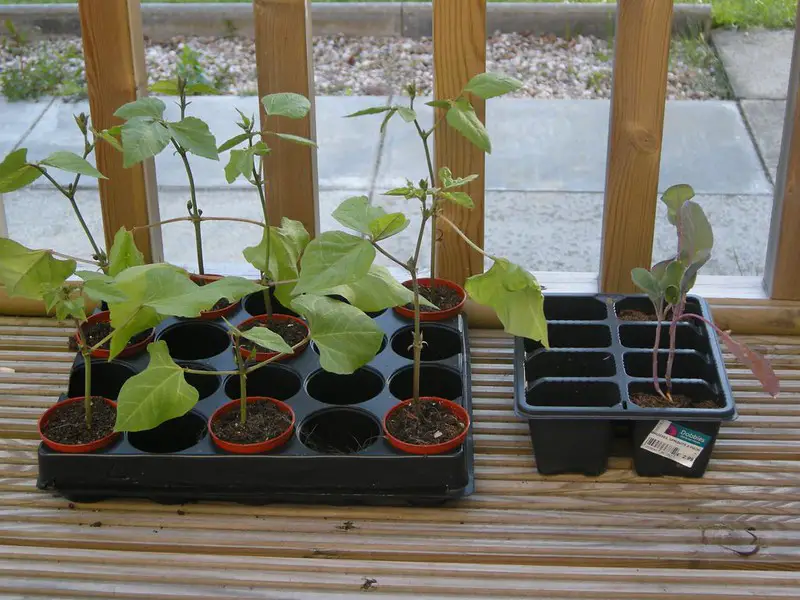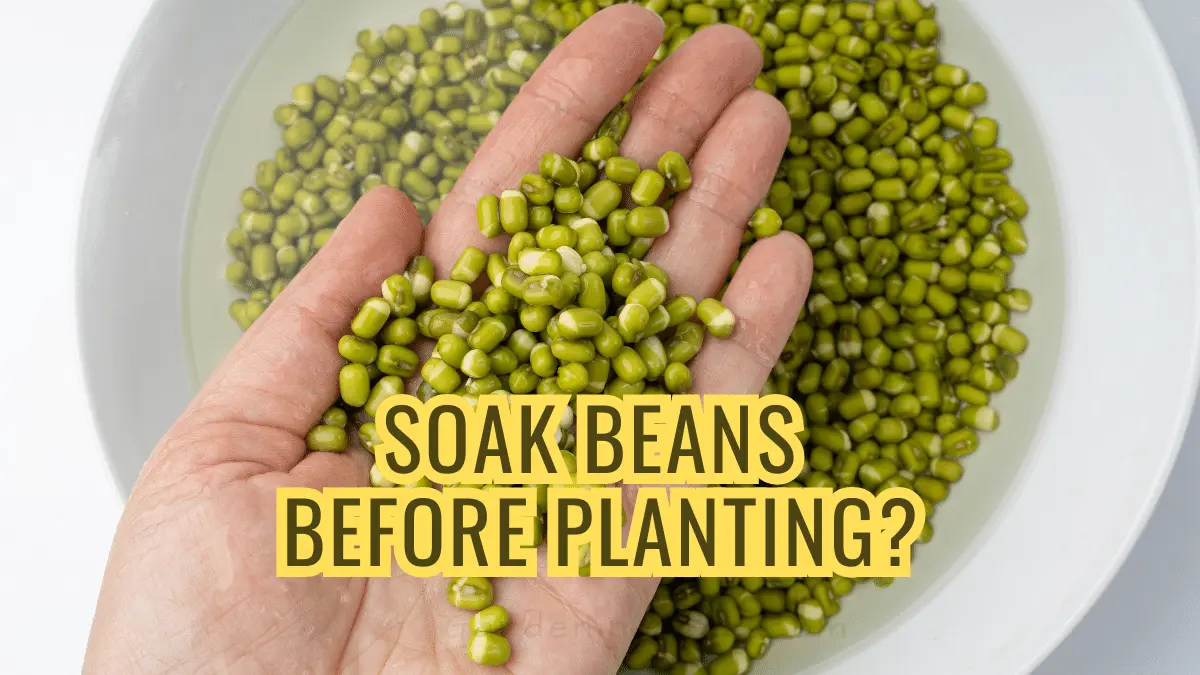We use affiliate links to run our site. When you buy through links on our site, we may earn an affiliate commission, without any added cost to you. Learn more
Soaking beans before planting is a common practice that many gardeners swear by. But is it really necessary?
Here’s a look at the reasons for and against pre-soaking beans and some tips to help you decide if it’s worth the extra time and effort.
Why Soak Beans Before Planting?
There are quite a few key reasons why soaking is traditionally recommended:

To Speed Germination:
Dry beans have hard outer coatings that can slow water absorption and delay germination. Soaking causes beans to swell and begin the germination process before planting by softening the seed coat. This gives the seed a head start, allowing it to break through the soil and sprout more quickly once planted.
To Improve Germination Rates:
In addition to accelerating germination, soaking can also increase overall germination rates. The hydration from soaking kickstarts the growth process and activates enzymes necessary for germination. This activity in the seed results in higher percentages of beans sprouting compared to unsoaked beans.
To Remove Growth Inhibitors:
Some varieties of beans contain chemical compounds that inhibit germination. Soaking leaches these growth inhibitors out of the beans and washes them away, supporting better germination.
To Prevent Rotting:
Beans that struggle to absorb water from the soil after planting are prone to rotting from excessive moisture. Pre-soaking ensures seeds have adequate hydration from the start, reducing the chance of waterlogged seeds succumbing to fungal diseases.
Growing Beans At Home: Everything From Planting To Harvesting [In A Nutshell]
Reasons to Avoid Pre-Soaking:
While pre-soaking has some benefits, there are also reasons many gardeners opt to skip it:

It’s an Extra Step:
Soaking beans adds time and an extra task to the planting process. For busy gardeners or those sowing larger volumes of beans, skipping soaking simplifies the process.
Soil Moisture is Often Adequate:
Beans sown in moist, loose soil will still absorb the water needed to kickstart germination, eliminating the need for pre-soaking. As long as soil moisture is sufficient, unsoaked beans will still sprout just fine.
Some Benefits are Minimal:
Research shows soaking improves germination rates by only a small percentage for many bean varieties. For gardeners who don’t need maximum germination, the couple of extra percent sprouting may not justify the hassle of pre-soaking.
It Can Invite Problems:
If not done properly, pre-soaking can actually cause issues. Leaving seeds soaking too long can lead to mold growth. And sowing beans while still wet can make them stick together when planted too close.
Cold Soil Temperatures:
Soaked beans sown in cold spring soil may rot rather than germinate. The energy, soaked beans use to sprout can deplete food reserves needed to push through the cold earth.
Tips for Pre-Soaking Beans:
If you do wish to pre-soak beans before planting, here are some tips for the best results:

- Soak seeds for 8-12 hours, no longer. Extended soaking can exhaust food reserves.
- Use room temperature water, around 70°F. Avoid cold water that could shock seeds.
- Place seeds in a bowl and add enough water to submerge by 2-3 inches.
- After soaking, rinse and drain beans very well before planting.
- Handle soaked seeds gently to avoid damaging sprouts.
- Allow soaked beans to dry slightly before planting if the soil is wet.
- Wait until the soil warms to at least 60°F before planting pre-soaked beans.
Can you oversoak beans?
Yes, it is possible to oversoak beans before planting. Here are a few key things to keep in mind about soaking times for beans:
- Soak for no longer than 24 hours. Any longer can lead to the exhaustion of food reserves needed for germination and growth. Extended soaking times beyond 24 hours will decrease germination rates.
- 12-18 hours is an ideal soaking time for most bean varieties. This allows ample water absorption while avoiding oversoaking.
- Avoid cold water for soaking. Use room temperature water around 70°F. Cold water can shock or damage seeds.
- Don’t soak too far in advance of planting. Plant soaked beans as soon as possible so they don’t dry out. Leaving them wet for days invites rot and mold.
- If in doubt, err on the side of less soaking time. A shorter 8-12 hour soak is less risky than soaking for a full 24 hours.
The key is allowing adequate hydration while not exhausting food stores needed for germination. Soaking overnight or during the day before planting is sufficient in most cases.
Monitor beans during soaking and drain immediately if any signs of sprouting or mold appear. Moderation is key to avoiding the potential downsides of oversoaking.

Do I Need to Soak All Types of Seeds Before Planting?
While soaking seeds before planting can benefit some types of seeds, it’s not a universal requirement for all seed varieties.
Whether or not you need to soak seeds depends on the specific characteristics of the seeds and the conditions in which you plan to plant them. Here are some guidelines to help you decide:
Seeds that Benefit from Soaking:
- Large Seeds: Seeds that are relatively large, such as beans, peas, and sunflower seeds, often benefit from soaking. These seeds have thicker seed coats that can be softened through soaking, aiding in germination.
- Seeds with Thick or Hard Coats: Seeds with hard or woody outer coatings, like morning glory or sweet pea seeds, can benefit from soaking to help break down the seed coat.
- Seeds Prone to Drying Out: In arid or dry climates, some seeds may benefit from pre-soaking to ensure they have enough moisture to germinate. This is especially relevant for seeds with a tendency to dry out quickly.
Seeds That Typically Don’t Require Soaking:
- Small Seeds: Tiny seeds, like those of many herbs (e.g., basil, thyme) or lettuce, often do not require soaking. They are generally more delicate and can be easily damaged during soaking.
- Fast-Germinating Seeds: Seeds that naturally germinate quickly and easily, such as radishes and mustard greens, may not need soaking because they have adapted to germinate rapidly without pre-soaking.
- Seeds with Thin Coats: Seeds with thin, delicate seed coats, like carrot seeds, usually do not require soaking.

So, while soaking can be a helpful technique for certain seeds, it’s not mandatory for all types. You should consider the specific characteristics of the seeds you are planting and the environmental conditions of your garden when deciding whether to soak them before planting.
Always refer to seed packet instructions or gardening references for guidance on seed preparation.
Final Thought:
Pre-soaking beans is recommended by many experts but not universally necessary. Pay attention to your specific planting conditions to decide if soaking makes sense for your garden.
Soaked beans may have better, faster germination but still need warm, moist soil to thrive. Weigh the benefits against the extra time required and pick the approach that fits your needs.
With a little trial and error, you can determine if pre-soaking helps or hinders your bean harvest. Adjust your techniques each season based on what works best for your unique growing environment.
That way, you can discover the ideal practices that result in a bountiful crop of your favorite beans.
Amazon and the Amazon logo are trademarks of Amazon.com, Inc, or its affiliates.

Hi there! My name is Prasenjit and I’m an avid gardener and someone who has grown a passion for growing plants. From my hands-on experience, I have learned what works and what doesn’t. Here I share everything I have learned.
